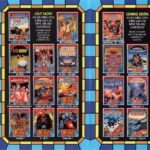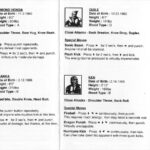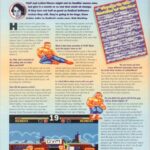1993 U.S. Gold
Platform: Amstrad CPC
Our next entry into the archives is one which has tormented Amstrad CPC users for many many years. But were they then perhaps saved from the lack of a Street Fighter 2 conversion?
Back in early 1993, U.S. Gold finally got 8-bit editions of Street Fighter 2 out for the Commodore 64 and ZX Spectrum. The C64 edition was pretty terrible, due to how it was rushed out. The ZX version looked very impressive with its large sprites, but was far too slow. However, the CPC version was nowhere to be seen.

During early 1993, places like Software City and MJC Computer Supplies were listing the game as being available to purchase on the CPC, when it clearly wasn’t available. There seemed to be all the right signals that the game was coming soon, and adverts for the home computer versions made that clear with it listed as coming soon on tape and disk.
The new editor of Amstrad Action, Tim Norris, then reported that the game was coming soon in issue 91, and each issue would go on to include a next month segment promising a review of the game. From this point, it started to become a bit of a running joke at the magazine where U.S. Gold kept fobbing the magazine off with constant delays.
After a few months months of speculation, Amstrad Action did a feature in issue 95 which tried to find out what was going on exactly. It was confirmed that Amstrad Action were due to get a review copy for issue 90, but it never appeared. They then subsequently got delay after delay from U.S. Gold up until that point.
According to the article, the CPC edition was being written by a coding team in France, and there had been communication problems with U.S. Gold. The team were apparently halfway to disbanding, and possibly scrapping the CPC version altogether. The official word though was that the game was still in development.
Did U.S. Gold just make that story up to Amstrad Action, if not – who could the French team have been? Was anyone disbanding around that time?
Apart from the odd joke and rumble at the magazine, there wasn’t much to report – apart from many letters from young readers asking where the game was. This triggered a rather funny list of top enquiries, mostly regarding the game.
By December 1993, the magazine finally heard something new and had a news item suggesting that a Street Fighter 2 review was now due for issue 100 of the magazine. Reportedly, U.S. Gold had told Amstrad Action that the game was coming straight out on their budget label in time for Christmas. Had this been made up just to fill up space in the magazine desperate for content?
Well, there was unsurprisingly not a peep of a review in issue 100, with Dave Golder replying to a letter asking where the review was and just saying “Not guilty on Street Fighter 2. It hasn’t come out yet.”. In his introduction for the issue, he explains that U.S. Gold reported that the projected release was a “clerical error” and they had no plans to ever release the game on the CPC that Christmas.
For their back issues for issue 95, they started to mention Street Fighter 2 with a line saying “the myth starts here”. In other responses to readers over time, it is mentioned that the game was now fully cancelled too.
Amstrad Action did a feature with Radical Software in issue 100 though, where they were developing Lethal Moves in a sort of response to the lack of a Street Fighter 2 conversion. Ironically, that game wouldn’t see release either, so expect a post on that game very soon too in the GTW archives.
There were final last ditch efforts to convince U.S. Gold to release the game, including a “Save Our Street Fighter” campaign where you could send off a slip to U.S Gold to beg for its release. It clearly didn’t work and CPC users were resigned to the fact it was never to be.
Did anything ever exist?
The question is whether anything was actually ever started, and was it indeed being developed by a French team?
Simon Hadlington mentioned in The Story of U.S. Gold history book that Tiertex produced the ZX edition, with Creative Materials handling all of the rest of the conversions. So, including the CPC edition too? If that is the case, could it be perhaps the same team as that behind Final Fight, and therefore the work of Richard Aplin?

Xyphoe did a brilliant stream of Richard Aplin’s games a few years ago on the Amstrad CPC. When it came to Final Fight, Richard initially said he had nothing to do with it. But as the video progressed, he spotted features that he recognised and concluded that it was indeed his work. It could be plausible that Richard did work on a CPC edition of Street Fighter 2, but may have forgotten that too (sadly Richard no longer has any of his old work anyway).
After our original post, Xyphoe got back to us and felt it was doubtful that Richard did the CPC edition of Street Fighter 2. However, he felt that the ZX version of SF2 did look like potentially Final Fight code with its large sprites. It’s also mentioned that Final Fight had been done using Richard’s code, but from what he recalls – Nick Vincent had used his codebase and routines.
Nick Vincent had done a similar thing with ESWAT on both the ZX Spectrum and Amstrad CPC. So if Nick did do the ZX version of Street Fighter 2, then it is very likely he was also behind the CPC edition and that it would have been full colour too.
Mauricio Muñoz Lucero also clarified and confirmed this too via email around the very same time. Mauricio and his team had researched the subject about the CPC version of the game last summer for their Spanish podcast. He mentioned that the possible candidate was Nick Vincent, who made CPC versions of ESWAT and Final Fight using code by Richard Aplin.
Their main source was an old Spanish interview with Richard in 2013, where the following was asked and answered:
Pablo: Why you were not compassionate with boys or girls who had to wait almost ten minutes loading E-SWAT stages to play less than 2 in most cases? Was it really necessary to do it that way?
Richard: Haha, I didn’t write CPC ESWAT. At least.. I don’t think I did..? I think Nick Vincent did it using my code and I’m pretty sure he was under a harsh deadline also. I’m guessing they didn’t use a fast loader, maybe he didn’t optimize things well. If I recall CPC Shinobi was a multiload as well, but it didn’t suck.
Mauricio suggests that Nick had access to Richard Aplin’s CPC version of Double Dragon 2 and used the code from that to do ESWAT and Final Fight for the CPC. He analyized the binary code of the two games against Double Dragon II and the three games share the same code for drawing tiles and sprites, although Nick’s work was not quite as well written as DD2.
Plenty of food for thought and a very strong candidate overall. Is anyone able to compare the ZX Street Fighter 2 code to that of ESWAT and Final Fight to see if they share the same/similar routines?
Whoever worked on the game, we believe there was something produced. U.S. Gold featured loading instructions within all the released versions (including even the budget version, though its likely they just took the full release copy of the instructions and replicated). If Amstrad Action didn’t mislead and U.S. Gold had indeed planned to release straight to budget, then perhaps it was even completed?
If that is the case, then why not release it? Answer = Money. U.S. Gold was a business, and they would not release a completed game for the sake of it if they felt it would lose money on it. We believe similar happened with Murder! on the Commodore 64 a few years before.
Towards the final year of their C64, Spectrum and Amstrad releases in 1993, the company was careful with what it released. It cancelled games like Mega Twins, but kept more high profile titles such as Indiana Jones – Fate of Atlantis and Street Fighter 2, because they probably knew they would sell just on the strength of the name and “eeek” that last drop of money out of the platforms.
If that is the case – then it begs the question as to why the CPC version of Street Fighter 2 wasn’t released, when the ZX version was – and especially when it was also released later on budget too. Perhaps U.S. Gold felt the ZX gaming market was stronger compared to the CPC one – perhaps their sales of ZX games just happened to be higher?
A poster on the CPC Wiki – Shaun M. Neary had contacted U.S. Gold back in the day to enquire, and they had even admitted to him that the writing was on the wall for the CPC. So it seemed unlikely even then that the game would ever see release in their eyes. Rumours that the game was going to be limited to a 128K release would also cut down a lot on potential sales too – perhaps this had some impact as well?
It sounds like U.S. Gold were only willing to release a conversion if the sales were going to be there to justify it. The interactions with Amstrad Action, and opportunity to contact U.S. Gold via Amstrad Action’s “Save Our Street Fighter” campaign were likely not responded to well enough for their liking. Just how many of the 20,000 odd readers (and sadly decreasing) fired off a response slip to them? Would it have made any difference?
It’s conjecture of course of what may or may not have happened. What is concerning and slightly telling is that there were never any preview screenshots (as far as we know) published of the development. However, maybe there is something out there yet to discover.
It may all just go back to the fact that the so called French team working on the game had disbanded and the game never got finished. Alternatively, perhaps it was merely a conversion of the ZX version that never got finished, and therefore was being done by the same developer as the ZX edition (there are suggestions it was by Tiertex, but by whom?).
Or did Nick Vincent really produce a conversion using his impressive sprite system that has since been long forgotten about?

Hopefully in time we will find out for sure and we will continue to update this page with any findings. If anyone has any suggestions regarding possible candidates for the French team (or any other details), or know how to contact Nick Vincent please let us know. There was a rumour of screenshots shown in another Amstrad magazine, but we haven’t been able to find anything.
In subsequent years, there have been various homebrew attempts (including a released conversion of the Gameboy edition) to bring the game to the CPC, and so its hoped that there will be a proper and decent conversion someday. Someone has also been attempting to port the ZX code by the looks of it too. Though many will still be curious to see how U.S. Gold’s official version was faring (if at all).
With thanks to Xyphoe for information from his video and later discussion about the developer, Mauricio Muñoz Lucero for discussions about the developer, Archive.org for scans, CPC-Power for the Final Fight screenshot, and World of Spectrum for some scans.


























Richard Aplin’s engine could have worked well but just like the Final Fight game, we would have had a lot of slowness, I like Richard’s games. Today some enthusiasts are going to release a Mighty street fighter homebrew, I am following the upcoming release. The game looks pretty but I hope it is fast.
If US Gold had released it at the time, it would have surely been complete shit like all the other versions they released! And I seriously doubt Richard Aplin would have abandoned the 16-bit machines at the time to go back and do a CPC version. It just doesn’t make sense.
I agree, I doubt it was by Richard either. We made the unlikely suggestion though, as in 1991 it was confirmed he did do the CPC edition of Final Fight, when he didn’t think he did. I would have loved to have seen Richard have a go at the conversion back then.
I was wrong Codetapper! – It seems like Nick Vincent used Richard’s code from Double Dragon 2 to do ESWAT and Final Fight. So, definitely not Richard – but possibly Nick Vincent.